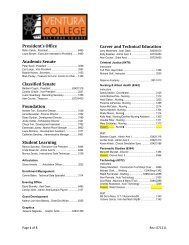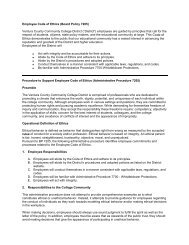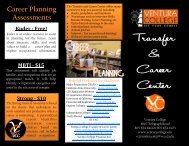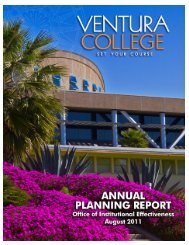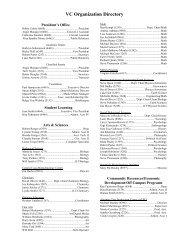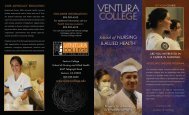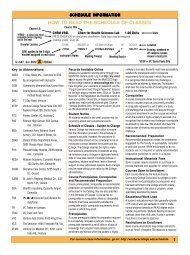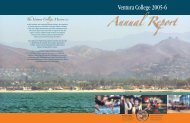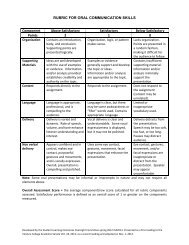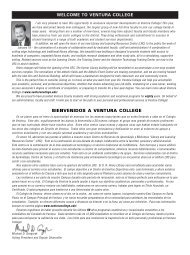2011 General CataloG & announCement of Courses - Ventura College
2011 General CataloG & announCement of Courses - Ventura College
2011 General CataloG & announCement of Courses - Ventura College
Create successful ePaper yourself
Turn your PDF publications into a flip-book with our unique Google optimized e-Paper software.
GEOGRAPHIC INFORMATION SYSTEMS (GIS) continued<br />
Select two (2) units from the following courses:<br />
GEOG V90 Directed Studies in Geography<br />
(in GIS/GPS Field Data Collection) .5-6<br />
GEOG V95/V96 Geography Internship I & II<br />
(in GIS/GPS Field Data Collection) 1-4/1-4<br />
9.5<br />
For other course descriptions, see Geography<br />
COURSE DESCRIPTIONS<br />
GIS V22 - FUNDAMENTALS OF MAPPING AND GEOGRAPHIC<br />
INFORMATION SYSTEMS - 3 Units<br />
Hours: 3 lecture weekly<br />
This course provides an introduction to the mapping sciences<br />
with a primary focus on Geographic Information Systems (GIS).<br />
This is the foundation course for the use <strong>of</strong> GIS s<strong>of</strong>tware. It covers<br />
the history, structure, uses, hardware and s<strong>of</strong>tware requirements,<br />
as well as the basic operations <strong>of</strong> GIS. It also examines the use <strong>of</strong><br />
other geographic technologies (maps, aerial photography, remote<br />
sensing, and global positioning systems (GPS)) as they relate to GIS<br />
use. Examples will be presented for the uses <strong>of</strong> GIS s<strong>of</strong>tware in a<br />
number <strong>of</strong> fields including business, city planning, natural resource<br />
management and scientific research. This course is recommended<br />
for anyone who is using or anticipates using any <strong>of</strong> the many types<br />
<strong>of</strong> data that can be mapped.<br />
Field trips may be required. Same as GEOG V22. Transfer credit:<br />
CSU; UC; credit limitations - see counselor.<br />
GIS V24 - INTRODUCTION TO GLOBAL POSITIONING SYSTEMS<br />
(GPS) - .5 Unit<br />
Hours: 1 lecture-laboratory weekly<br />
This course is designed to introduce Global Positioning Systems<br />
(GPS) to those who are considering using a hand-held GPS receiver<br />
for navigating in recreational activities, work. or research. The course<br />
will be a combination <strong>of</strong> classroom instruction and practical handson<br />
exercises.<br />
Field trips may be required. May be taken for a maximum <strong>of</strong> 2<br />
times. Same as GEOG V24. Offered on a pass/no pass basis only<br />
GIS V26 - INTRODUCTION TO GEOGRAPHIC INFORMATION<br />
SYSTEMS SOFTWARE - 2 Units<br />
Hours: 2 lecture weekly<br />
This course is a hands-on computer-based mapping course<br />
covering the elements and procedures <strong>of</strong> using a Geographic<br />
Information Systems (GIS) s<strong>of</strong>tware package (ArcGIS) to learn GIS<br />
concepts. It covers all <strong>of</strong> the basic skills needed for operating GIS<br />
including creating and editing digital maps, database access and<br />
editing, basic cartographic principles, and introductory GIS analysis.<br />
It also reviews various application areas that use GIS.<br />
Field trips may be required. Same as GEOG V26. Transfer credit:<br />
CSU; credit limitations - see counselor.<br />
GIS V28 - GEOGRAPHIC INFORMATION SYSTEMS (GIS)<br />
APPLICATIONS: PROJECT DEVELOPMENT - 1.5 Units<br />
Prerequisite: GIS V26 or GEOG V26<br />
Recommended preparation: GIS V22 or GEOG V22<br />
Hours: 3 lecture-laboratory weekly<br />
This course is an exploration <strong>of</strong> various Geographic Information<br />
Systems (GIS) techniques and concepts through an active learning<br />
approach. Students will define, propose, design, and execute a<br />
project that will incorporate GIS skills and knowledge.<br />
Field trips may be required. May be taken for a maximum <strong>of</strong> 4<br />
times. Same as GEOG V28.<br />
GEOGRAPHY<br />
GEOG V01 - ELEMENTS OF PHYSICAL GEOGRAPHY - 3 Units<br />
Hours: 3 lecture weekly<br />
This course is a spatial study <strong>of</strong> planet earth’s dynamic<br />
physical systems and processes. Topics include weather, climate,<br />
geomorphology, soils, and the biosphere. The emphasis is on<br />
interrelationships among systems and processes and their resulting<br />
patterns and distributions. Tools <strong>of</strong> geographic inquiry include maps,<br />
remote sensing, graphic data, and models.<br />
Field trips may be required. Formerly Geog 1. Transfer credit:<br />
CSU; UC.<br />
GEOG V01L - ELEMENTS OF PHYSICAL GEOGRAPHY<br />
LABORATORY - 1 Unit<br />
Prerequisite: GEOG V01 or concurrent enrollment<br />
Hours: 3 laboratory weekly<br />
This laboratory course is designed to be the hands-on<br />
measurement, computational and data analysis portion <strong>of</strong> the<br />
course. By using specific data, either provided by the instructor or<br />
generated by the students, activities focus on the detailed aspects<br />
and general patterns associated with the hydrosphere, atmosphere,<br />
lithosphere and biosphere. Specific activities include: topographic<br />
map interpretation/use/preparation, reading/preparing charts and<br />
tables, manipulation <strong>of</strong> numerical data, and learning/performing field/<br />
laboratory techniques common to the discipline.<br />
Field trips may be required. Formerly Geog 1L. Transfer credit:<br />
CSU; UC.<br />
GEOG V02 - INTRODUCTION TO HUMAN<br />
GEOGRAPHY - 3 Units<br />
Hours: 3 lecture weekly<br />
This course is a study <strong>of</strong> diverse human populations, their cultural<br />
origins, diffusion, and contemporary spatial expressions. Topics<br />
include demography, languages and religions, urbanization and<br />
landscape modification, political units and nationalism, and economic<br />
systems. Consideration is given to interrelationships between human<br />
activities and the physical environment.<br />
Formerly Geog 2. Transfer credit: CSU; UC.<br />
GEOG V05 - INTRODUCTION TO WEATHER AND<br />
CLIMATE - 3 Units<br />
Hours: 3 lecture weekly<br />
This course is a nontechnical study <strong>of</strong> the earth’s atmospheric<br />
phenomena; the basic weather elements - temperature, pressure, and<br />
moisture conditions and the recording <strong>of</strong> data; investigation into the<br />
causes <strong>of</strong> weather and the world climate pattern.<br />
Field trips may be required (may be scheduled on Saturday).<br />
Formerly Geog 5. Transfer credit: CSU; UC.<br />
GEOG V06 - GEOGRAPHY OF CALIFORNIA - 3 Units<br />
Hours: 3 lecture weekly<br />
This course is an introduction to the geography <strong>of</strong> California - its<br />
natural setting <strong>of</strong> mountains, valleys, deserts and coastline, and<br />
how people have adapted to this unique environment. Topics to<br />
be examined include weather and climate, agricultural activities,<br />
settlement patterns, use <strong>of</strong> natural resources, industry and<br />
manufacturing, and the problems facing California today.<br />
Field trips may be required (may be scheduled<br />
on Saturday). Formerly Geog 6.<br />
Transfer credit: CSU; UC.<br />
<strong>Ventura</strong> <strong>College</strong> Catalog 2010 - <strong>2011</strong> Credit <strong>Courses</strong>, Degrees, Certificates, and Awards 145



